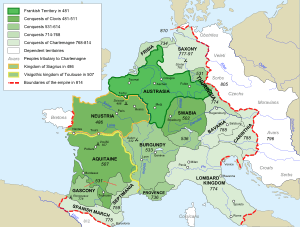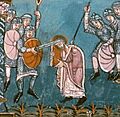Frisian–Frankish wars facts for kids
Quick facts for kids Frisian-Frankish War |
|||||||
|---|---|---|---|---|---|---|---|
 Map of the Frankish Empire from 481 to 814 |
|||||||
|
|||||||
| Belligerents | |||||||
| Frankish kingdom | Frisian kingdom | ||||||
The Frisian–Frankish wars were a series of fights between the powerful Frankish kingdom and the Frisian kingdom. These conflicts happened in the 600s and 700s.
The main reason for these wars was control over the Rhine delta, a very important area for trade and travel. After the Frisian king Redbad died, the Franks started to win more often.
In 734, the Frisians were badly beaten at the Battle of the Boarn. The Franks then took over the Frisian lands between the Vlie and the Lauwers rivers. Only the Frisians living east of the Lauwers river stayed independent for a while.
But in 772, they also lost their freedom. The wars finally ended in 793 with the last Frisian uprising. After this, the Frisians were brought under Frankish rule by Charlemagne, a famous Frankish king.
Contents
Why the Wars Started
Long ago, during a time when many people moved around Europe, different groups settled in new places. The Frisians settled in the north and west of what is now the Low Countries (like the Netherlands). The Saxons lived in the east, and the Franks settled further south around the Scheldt river.
The Franks, led by their Merovingian kings, became very important in the politics of northern Gaul (modern-day France).
The Frisians were made up of many small tribes. These tribes worked together in war groups, but they weren't a single, strong kingdom at first. In the late 600s, the Frisian kingdom grew a lot. Frisian kings, like Aldgisl, started to take over lands that used to belong to the Franks.
Fighting for the Rhine Delta
Frankish records mention a Merovingian king named Chilperic I (who ruled from 561 to 584). They called him the "terror of the Frisians." This shows that there were already tensions between the two groups.
Around 630, things changed. The Merovingian king Dagobert I managed to unite the Frankish Empire again. He conquered the lands south of the Oude Rijn river. The Franks also brought Christianity to the Frisian lands and built a church in Utrecht.
However, after Dagobert died, the Franks couldn't keep control. By 650, the central river area, including the important trading town of Dorestad, became Frisian again. Frankish coins were no longer made there, and Utrecht became a home for Frisian kings.
Under King Aldgisl, the Frisians clashed with a powerful Frankish official called Ebroin. This fight was about old Roman border forts. Aldgisl used his army to keep the Franks away. In 678, he even welcomed an English bishop named Wilfrid, who also didn't get along with Ebroin.

When Aldgisl's successor, Redbad, took over, the Franks started to gain power. By 689, a powerful Frankish official named Pepin of Herstal had united several Frankish regions. In 690, Pepin won a big battle at Dorestad.
After this victory, Dorestad became Frankish again, along with the forts of Utrecht and Fechten. It seems the Franks now controlled the area from south of the Oude Rijn all the way to the coast. A bishopric (church area) was set up for Willibrord to spread Christianity among the Frisians. Also, Pepin's oldest son, Grimoald the Younger, married Redbad's daughter, Thiadsvind, in 711. This marriage was likely meant to create peace.
When Pepin died in 714, Redbad got involved in the fight for power among the Franks. He made a deal with a new Frankish official named Ragenfrid. In 716, their armies marched into Frankish territory and won a battle near Cologne. Because of this, all the lands south of the Rhine river became Frisian again.
Redbad planned another invasion of the Frankish kingdom. He gathered a large army, but he became sick and died in 719 before he could attack.
After Redbad's death, it's not clear who became the next Frisian leader. There might have been problems with who should rule. This made it easy for the Frankish leader Charles Martel to invade Frisia. He took over the Frisian lands south of the Rhine and even crossed the river to take more territory, reaching the Vlie river.
The End of Frisian Independence
In 733, Charles Martel sent his army against the Frisians again. The Frisian king Poppo was defeated and pushed back. The next year, Charles used a fleet of ships to cross a lake called Almere and sail up to De Boarn.
The Frisians were defeated in the Battle of the Boarn, and King Poppo was killed. The Franks took many treasures and burned down non-Christian holy places. Charles Martel returned with lots of loot. This victory broke the power of the Frisian kings for good. The Franks officially took over the Frisian lands between the Vlie and the Lauwers rivers.
Taking Over East Frisia
The famous Frankish king Charlemagne eventually ended the independence of the Frisians living east of the Lauwers river. He expanded the Frankish Empire even further east. This war started with a campaign against the East Frisians and then continued against the Saxons. The Saxon Wars would last for 32 years.
In 772, Charlemagne attacked the Frisians east of the Lauwers and the Saxons with a huge army. He defeated them in several battles. This meant that the last independent Frisian lands and the Saxon lands came under Frankish control.
Frisian Rebellions
Even after their defeats, the Frisians rebelled against the Franks several times.
The Murder of Saint Boniface

The first Frisian bishop, Boniface, traveled to Frisia in 754 with a small group of helpers. He baptized many people and planned a big meeting near Dokkum. Instead of new Christians, a group of armed Frisians appeared.
These Frisian warriors were angry because Boniface had destroyed their old holy places. They killed the old bishop because they thought his chests contained gold. But they were disappointed to find only books inside.
Rebellion of 782-785
Under the leadership of Widukind, the Saxons continued to fight against the Franks. In 782, the Frisians east of the Lauwers also started a rebellion against the Franks. This uprising spread to the western Frisian lands that had been taken over earlier.
Many people went back to their old paganism (non-Christian beliefs). Attackers burned churches, and priests, like Ludger, had to run away to the south.
In response, Charlemagne organized a new military campaign in 783 to get control back. He first dealt with the Saxons and then the Frisians. The Frisians helped Widukind against the Franks in 784 by sending an army. But it wasn't enough, and Widukind had to surrender in 785. The Frisian rebellion was put down very harshly by the Franks.
Rebellion of 793
In 793, the Frisians rebelled for the last time against Charlemagne. The reason was that the Franks were forcing Frisians and Saxons to join their army to fight against the Avars in the east.
Led by chiefs Unno and Eilrad, a rebellion started east of the Lauwers and spread to other Frisian areas. Again, people temporarily went back to their old beliefs, and priests had to flee.
However, this uprising was also crushed by the Franks.
Images for kids


